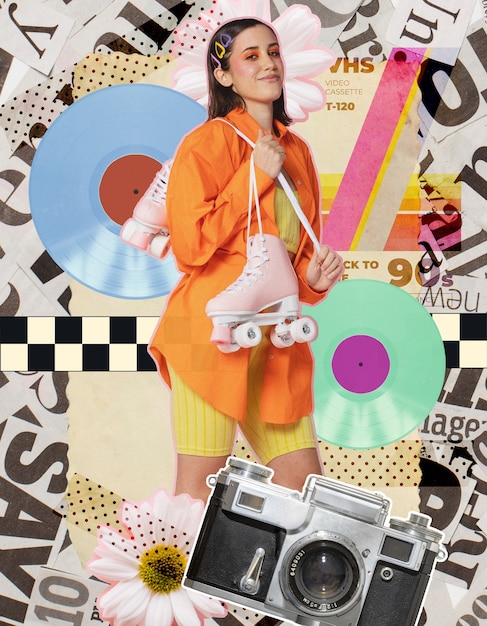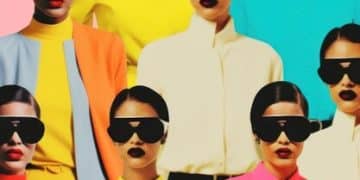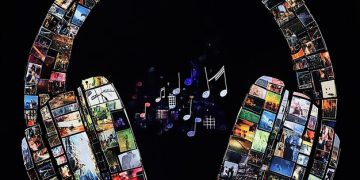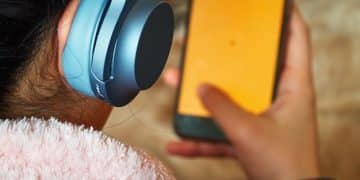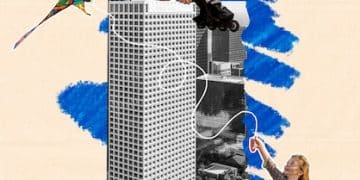90s Pop Culture: Driving 2025 Fashion Trends
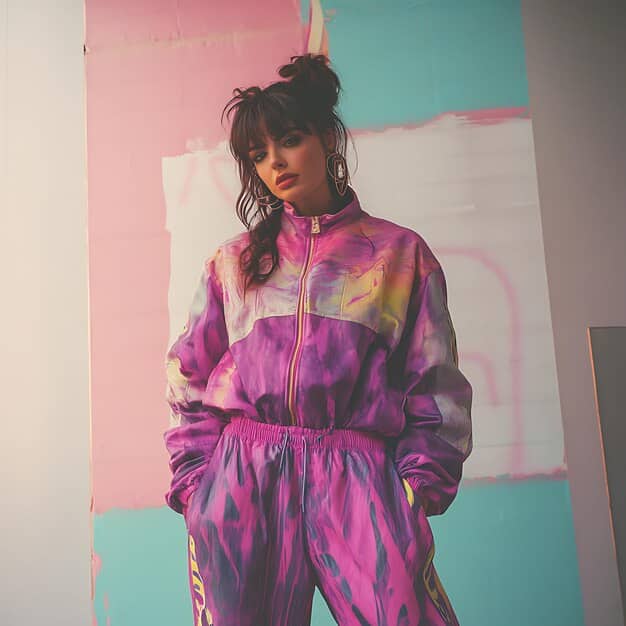
The strong return of 1990s pop culture is profoundly influencing 2025 fashion trends, bringing back iconic styles from grunge to minimalist chic and redefining contemporary aesthetics with a nostalgic yet fresh perspective.
The 1990s, a decade often characterized by its distinctive music, film, and fashion, is making a powerful comeback. As we look towards 2025, it’s becoming increasingly clear that the **resurgence of 90s pop culture is impacting 2025 fashion trends** in profound and exciting ways. This retrospective glance isn’t merely about replicating past looks; it’s about reinterpreting them through a modern lens, reflecting evolving sensibilities while embracing nostalgia.
The Cultural Zeitgeist: Why the 90s Now?
The fascination with the 1990s is undeniable. From streaming platforms reviving beloved sitcoms to TikTok trends echoing iconic fashion moments, the decade’s pervasive influence is everywhere. This isn’t just a fleeting trend; it’s a deep dive into an era that offered a unique blend of post-Cold War optimism, burgeoning digital landscapes, and a counter-cultural explosion.
There’s a cyclical nature to fashion and cultural trends, and the 90s wave is perhaps one of the most resonant in recent memory. For many, it represents a pre-internet innocence, a time when cultural touchstones felt more tangible and less fragmented by endless digital streams. For younger generations, it’s an exhilarating discovery of a world that feels both refreshingly analogue and surprisingly relevant.
The socio-economic landscape of the 90s, characterized by a certain anti-establishment sentiment and a search for authenticity, finds parallels in today’s world. As consumers seek unique expressions and move away from fast fashion’s uniformity, the individuality championed by 90s styles offers a compelling alternative. This decade laid the groundwork for many contemporary movements, including indie music, street art, and early digital art, all of which now intertwine with fashion.
Nostalgia and its Therapeutic Appeal
Nostalgia, particularly for a bygone era, can offer a sense of comfort and stability in turbulent times. The 90s represent a period of significant cultural shifts but also a certain simplicity compared to the rapid pace of current technological advancements. This emotional connection draws consumers back to styles that evoke a sense of familiarity and warmth, making them eager to embrace these renewed aesthetics in their wardrobes.
- Escape from Complexity: The 90s offer a cultural refuge from today’s overwhelming digital and social complexities.
- Intergenerational Appeal: Adults relive their youth, while Gen Z discovers “new” aesthetics.
- Simplicity and Authenticity: A return to less ostentatious, more genuine expressions of style.
Furthermore, the 90s marked a pivotal moment for celebrity culture and the rise of the supermodel, figures who became style icons and tastemakers. Their influence, now amplified by social media archives, continuously fuels interest in their signature looks, making them a wellspring for modern designers and fashion enthusiasts alike.
Key 90s Fashion Aesthetics Making a Comeback
The 90s were not a monolithic fashion landscape; they encompassed a diverse range of styles, from grunge rock to sleek minimalism. Each sub-genre contributed to the decade’s rich sartorial tapestry, and it’s this very diversity that makes its resurgence so appealing and adaptable for 2025 fashion trends. Designers are cherry-picking elements from various 90s aesthetics, blending them to create fresh, contemporary looks that still carry that unmistakable retro vibe.
One of the most prominent returns is grunge. Think oversized flannel shirts, ripped denim, band tees, and combat boots. This anti-fashion stance was a rebellious counterpoint to the polished looks of the 80s, and its raw, authentic appeal resonates strongly with today’s youth-driven fashion movements. But it’s not just about replicating the exact looks; it’s about channeling the attitude—a blend of apathy and genuine self-expression that feels ironically relevant in an era of curated online personas.
Minimalism and its Enduring Appeal
In stark contrast to grunge, 90s minimalism offered clean lines, neutral palettes, and a focus on quality over excess. Influenced by designers like Calvin Klein and Helmut Lang, this aesthetic emphasized simplicity, comfort, and understated elegance. Slip dresses, tailored trousers, simple camisoles, and streamlined silhouettes are all seeing a significant revival. This return to basics aligns with a growing desire for sustainable and timeless pieces that transcend fleeting trends.
- Sleek Silhouettes: Emphasis on clean lines and uncomplicated forms.
- Neutral Color Palettes: Blacks, whites, grays, and earthy tones dominate.
- Quality Fabrics: Focus on well-made, durable garments over fleeting fast fashion.
Another strong influence comes from the preppy and “Clueless” aesthetic. Plaid skirts, crop tops, knee-high socks, and pastel colors are being reinterpreted with a modern twist. This playful, often satirical take on hyper-femininity and consumerism offers a lighter, more whimsical counterpoint to the edgier grunge or understated minimalism. It speaks to a desire for playful expression and embracing overt femininity without apology, a sentiment gaining traction in 2025.

From Runways to Retail: How 90s Influence is Manifesting
The journey of 90s fashion from being a nostalgic reference to a mainstream trend for 2025 involves a calculated translation from high fashion runways to accessible retail. Designers are not just copying; they are creatively reinterpreting, adapting the core elements of 90s aesthetics to fit contemporary lifestyles and sensibilities. This thoughtful evolution is what makes the trend more than just a fleeting revival, cementing its place in the modern fashion landscape.
On the runways, we’ve seen various interpretations of 90s themes. From oversized silhouettes reminiscent of hip-hop styles to slip dresses paired with chunky knitwear, designers are embracing the decade’s diverse nature. Brands are increasingly featuring models with an “effortlessly cool” vibe, echoing the minimalist approach to styling prevalent in the 90s. This deliberate aesthetic choice signals a shift away from overly complex or overtly structured ensembles towards a more relaxed yet stylish approach.
The Role of Social Media in Amplifying 90s Trends
Social media platforms, particularly TikTok and Instagram, have become powerful catalysts for the 90s fashion resurgence. Influencers and content creators regularly showcase “get ready with me” videos featuring 90s-inspired outfits, driving viral trends and introducing these styles to a new generation. Hashtags like #90sFashion and #VintageStyle accumulate billions of views, creating a self-sustaining cycle of inspiration and adoption. This digital amplification means trends disseminate faster and reach a wider audience than ever before.
- Viral Challenges: TikTok challenges centered around 90s outfit recreations boost visibility.
- Influencer Endorsement: Fashion influencers demonstrate how to style vintage pieces for modern appeal.
- User-Generated Content: Millions of users share their own 90s-inspired looks, fostering a community around the trend.
Retailers, quick to capitalize on this demand, are stocking their shelves with updated versions of 90s classics. From wide-leg jeans and crop tops to chunky sneakers and baguette bags, contemporary brands are ensuring that these nostalgic pieces are readily available. This accessibility, combined with strategic marketing campaigns that tap into the decade’s cultural references, ensures that 90s fashion is not just visible, but deeply integrated into the consumer market for 2025.
The beauty of this current wave is its adaptability. Consumers aren’t confined to a single 90s aesthetic. They can mix and match, combining grunge elements with minimalist pieces, or adding a touch of preppy chic to an otherwise casual outfit. This freedom of expression reflects a broader shift in fashion, where personal style and individuality are prioritized over adherence to rigid trends, making the 90s revival incredibly versatile.
Beyond Clothing: 90s Beauty, Hair, and Accessories
The resurgence of 90s pop culture in 2025 extends far beyond apparel, deeply influencing beauty, hair, and accessory trends. These elements are crucial for completing the overall aesthetic, allowing for a fully immersive dive into the decade’s iconic looks. The minimalist, yet sometimes edgy, approach to beauty in the 90s provides a compelling contrast to more elaborate recent trends, offering a refreshing simplicity that resonates with contemporary preferences.
In beauty, the emphasis is on a more natural, understated look with a few bold accents. Think matte skin, subtle contouring, and defined brows. The “no-makeup makeup” trend, popular then and now, often featured a perfected base paired with a nude or brown lip liner and lipstick. Darker, gothic-inspired lip shades are also making a comeback, reflecting the moodier side of 90s fashion, particularly from the grunge and alternative scenes. Eyeshadows tend to be more muted, often using earthy tones or soft metallics, with a focus on defining the lash line rather than dramatic wings.
Hair Trends: From Sleek to Spiky
90s hair trends were incredibly diverse, ranging from super-sleek and straight styles to playful, spiky looks. The “Rachel” haircut, a layered bob popularized by Jennifer Aniston, remains an iconic symbol of the era, and modernized versions of layered cuts are gaining traction. Claw clips, once a casual hair accessory, are now statement pieces, often used to create effortless updos or half-up styles. Scrunchies are also back in full force, adding a pop of color and texture to ponytails and buns.
- Sleek & Straight: Poker-straight hair, often with a middle part, is back.
- Claw Clips & Scrunchies: Essential accessories for effortless, retro hair styling.
- Baby Braids & Face-Framing Tendrils: Small, delicate braids and loose strands framing the face add a playful touch.
Accessories play a vital role in encapsulating the 90s aesthetic. Chunky combat boots and platform sneakers provide a grounded, edgy foundation. Micro sunglasses, often oval or rectangular, instantly scream 90s chic and are perfect for adding an understated cool factor. Shoulder bags, particularly the iconic baguette silhouette, are practical yet stylish, complementing virtually any outfit. Layered chain necklaces and chokers also contribute to the decade’s distinct jewelry landscape, offering a blend of grunge and minimalist elegance.
The reintroduction of these beauty, hair, and accessory elements allows for a comprehensive embrace of the 90s influence. It provides consumers with the tools to adopt the trend subtly or go all-in, creating complete looks that genuinely reflect the decade’s unique appeal. This holistic approach ensures that the 90s resurgence is more than just a fleeting clothing trend, but a full-fledged cultural phenomenon shaping 2025’s aesthetic landscape.
The Sustainability Angle: Vintage & Upcycled 90s Fashion
The current resurgence of 90s pop culture in fashion for 2025 isn’t solely driven by nostalgia and aesthetics; it also aligns remarkably well with growing concerns about sustainability and ethical consumption. The trend has inadvertently become a champion for vintage and upcycled clothing, offering a more eco-conscious alternative to fast fashion and encouraging a circular economy within the industry. This convergence of style and environmental awareness is a powerful force shaping consumer behavior.
Diving into 90s fashion means embracing pre-loved garments. Thrift stores, vintage shops, and online marketplaces are treasure troves for authentic 90s pieces—from oversized denim jackets and graphic tees to slip dresses and distressed jeans. Opting for vintage over new significantly reduces carbon footprints, conserves resources, and mitigates textile waste. Consumers are not just buying clothes; they are investing in pieces with a story, contributing to a more mindful approach to style.
Upcycling and Creative Reinterpretation
Beyond simply buying vintage, the 90s trend is also fueling the upcycling movement. Designers and individual creators are taking old 90s garments and transforming them into fresh, modern pieces. A pair of oversized 90s jeans might be cut and sewn into a unique skirt or a patchwork top. Old band tees are being deconstructed and reimagined into new designs. This creative process not only extends the life of clothing but also fosters individuality and unique self-expression, moving away from mass-produced uniformity.
- Reduced Waste: Buying vintage or upcycled means less new clothing production and less landfill waste.
- Unique Pieces: Each vintage item has its own history, offering unparalleled individuality.
- Support for Circular Economy: Encourages reuse, repair, and recycling within the fashion industry.
The accessibility of 90s styles, combined with their inherent durability (many 90s garments were made with higher quality materials than today’s fast fashion counterparts), makes them ideal candidates for a sustainable wardrobe. This movement is powered by a growing consumer base, particularly among Gen Z, who prioritize ethical consumption and seek to align their purchasing habits with their values. They view fashion as a statement not just about style, but about social and environmental responsibility.
The intersection of 90s pop culture’s fashion influence and the sustainability movement creates a virtuous cycle. As the demand for 90s aesthetics grows, so does the market for vintage and upcycled goods, further cementing sustainable practices within the mainstream. This holistic approach to fashion, where style meets conscience, is poised to have a lasting impact on how we consume clothing in 2025 and beyond, making the 90s revival not just stylish but also responsible.
Looking Ahead: What 2025 Holds for 90s-Inspired Fashion
As we project into 2025, the influence of 90s pop culture on fashion is unlikely to wane; rather, it is set to evolve and deepen. This isn’t merely a fleeting trend destined to disappear, but a foundational shift in how we perceive and integrate historical aesthetics into contemporary design. The key to its longevity lies in its adaptability and the ongoing conversation between nostalgia and innovation.
Future interpretations of 90s fashion will likely lean further into personalization and hybrid aesthetics. We can anticipate seeing more sophisticated blends of grunge and minimalism, or preppy elements infused with sporty influences, all characteristic of the 90s yet distinctly modern. Designers will continue to draw inspiration from specific subcultures and iconic moments of the decade, but always with an eye towards functionality, comfort, and sustainability—values that resonate strongly with today’s consumers.
The Rise of “Clean 90s” and Functional Minimalism
One emerging direction is the “clean 90s” aesthetic, which amplifies the minimalist aspects of the decade. This future iteration focuses on refined silhouettes, premium fabrics, and a timeless color palette, eschewing overt branding or excessive ornamentation. It emphasizes versatility and longevity, aligning with a desire for capsule wardrobes and investment pieces. This functional minimalism embodies the quiet luxury trend but with a distinct 90s undertone, making it both practical and chic for 2025.
- Refined Silhouettes: Emphasis on structured yet relaxed forms.
- Premium Materials: Focus on natural fibers and high-quality textiles for durability.
- Understated Luxury: Minimalism with a focus on craftsmanship and subtle detailing.
Furthermore, expect to see the continued reinterpretation of 90s workwear and utilitarian styles. Boiler suits, cargo pants, and practical outerwear are likely to be elevated with more tailored cuts and luxurious fabrics, blurring the lines between casual and formal. This reflects a broader societal shift towards versatile clothing that can transition seamlessly between different aspects of daily life, a practical approach that harks back to the functional roots of much 90s fashion.
The role of digital fashion and virtual experiences will also play a part. As the metaverse and digital clothing gain traction, 90s aesthetics may find new life in virtual wardrobes, allowing for experimental and boundary-pushing interpretations that transcend physical limitations. This fusion of retro inspiration with futuristic technology signals an exciting new frontier for the 90s influence, ensuring its relevance far into the future.
Ultimately, the enduring appeal of the 90s in 2025 fashion trends lies in its ability to offer a diverse toolkit for self-expression. It’s a decade rich in stylistic paradoxes—rebellion meets sophistication, simplicity meets theatricality—providing an endless source of inspiration that designers and consumers will continue to explore and reinvent.
| Key Aspect | Brief Description |
|---|---|
| 👕 Style Diversity | From grunge to minimalism, the 90s offer a rich, adaptable fashion palette for 2025. |
| ♻️ Sustainability Link | Revived 90s trends promote vintage finds and upcycling, aligning with eco-conscious consumption. |
| 📱 Digital Amplification | Social media platforms accelerate trend adoption, making 90s fashion globally accessible. |
| ✨ Holistic Influence | Beyond clothes, 90s beauty, hair, and accessories complete the iconic aesthetic. |
Frequently Asked Questions about 90s Fashion in 2025
The 90s offer a blend of nostalgia, diversity in styles (from grunge to minimalism), and a perceived simplicity compared to today’s complex world. This era’s influence resonates across generations, providing comfort for some and fresh discovery for others, aligning with current desires for authenticity and unique self-expression in fashion.
Key items making a strong comeback include oversized flannel shirts, ripped denim, slip dresses, tailored minimalist pieces, wide-leg jeans, chunky sneakers, and baguette bags. These are being reinterpreted with modern fabrics and cuts, ensuring they feel current while retaining their nostalgic essence.
Social media platforms like TikTok and Instagram act as powerful trend incubators. Influencers showcase 90s-inspired outfits, driving viral challenges and trends. This widespread digital visibility rapidly normalizes and popularizes 90s aesthetics, making them accessible and appealing to a global audience, especially younger demographics.
Yes, the 90s fashion resurgence strongly supports sustainability. It encourages buying vintage, thrifting, and upcycling garments, which reduces textile waste and carbon footprints. This aligns with a growing consumer demand for ethical fashion, positioning the trend as not just stylish but also environmentally conscious for the long term.
In beauty, expect matte skin, subtle contouring, defined brows, and brown/nude lip shades. Hair trends include sleek, straight styles, modern layered cuts reminiscent of “The Rachel,” and the widespread use of claw clips and scrunchies. These elements complete the authentic 90s look with a refreshed appeal.
Conclusion: The Enduring Allure of the 90s Reshaping Tomorrow’s Style
The undeniable influence of 90s pop culture on 2025 fashion trends is a testament to the decade’s unique blend of rebellious spirit, minimalist elegance, and playful charm. More than just a passing fad, this resurgence reflects a deeper cultural yearning for authenticity, comfort, and sustainable practices. As designers continue to reinterpret its rich aesthetics, the 90s serve as a powerful wellspring of inspiration, proving that truly iconic styles never truly fade away; they simply evolve, ensuring their relevance for generations to come and reshaping how we dress, think, and interact with fashion in the years ahead.
